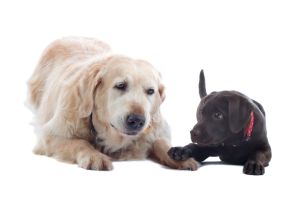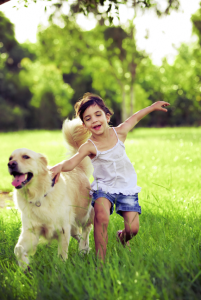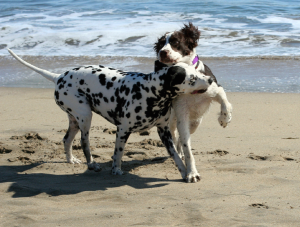 Butts up in the air, after a quick play bow, the dogs take off running, barking, jumping, chasing, growling, stalking and mouthing. Dogs having a good time playing together are quite a spectacle to watch! They can go from stalking each other in complete stillness to a lightening fast chase in the blink of an eye. More than simple fun, active playing is a critical component in the life of a well-adjusted dog. Our rowdy canines burn off energy during play of course, but they also practice their social skills, develop relationships with others, and maintain or gain emotional balance. Preventing dogs, or any animal from playing, may have devastating effects on their social development and emotional state.
Butts up in the air, after a quick play bow, the dogs take off running, barking, jumping, chasing, growling, stalking and mouthing. Dogs having a good time playing together are quite a spectacle to watch! They can go from stalking each other in complete stillness to a lightening fast chase in the blink of an eye. More than simple fun, active playing is a critical component in the life of a well-adjusted dog. Our rowdy canines burn off energy during play of course, but they also practice their social skills, develop relationships with others, and maintain or gain emotional balance. Preventing dogs, or any animal from playing, may have devastating effects on their social development and emotional state.
Research suggests that playtime offers a safe environment during which the animals can learn what is socially acceptable or not, how hard can they bite, how rough can they play, how much can they push, before triggering a negative reaction from others (Bekoff, 2001). During play, all mammals develop and practice their social repertoire and cognitive skills that will allow them to get along with others and ‘play fair’. They learn how to cooperate and how to reciprocate. When they don’t play by the rules, the play session may come to an end. They learn how to pay attention to the strength and weaknesses of others, to self-handicap when needed to keep the game equal. Self-handicapping occurs when one individual purposely adjusts their play to the age or size of their playmate. A large dog may for instance lie down while the puppy climbs all over him, play more gently and run slower, allowing the puppy to keep up. What better way for the brain to ensure that the animal will repeat this social requirement over and over again, than to make this activity intrinsically pleasant!
 When mammals have fun, they experience a release of endorphins (opioids) in the brain. So playing is not just a great way to learn how to be social, it also serves a function in maintaining a healthy emotional and hormonal balance. The release of endorphins influences many brain functions, from the control of appetite to the enhancement of the immune system, the reduction of stress and of course the feeling of euphoria. Play is so important, for all species, including humans, that scientists are sounding the alarm on the need to reintroduce playtime in our schools. With the decline of recess and free time to play, more children are experiencing anxiety, depression, feelings of helplessness and even suicide (Gray, 2011). Moreover, an: “all work, no play” attitude may have devastating consequences as severe play deprivation can lead to serious psychopathologies. It doesn’t matter the species, whether a rat, a horse, a dog or a human, playing promotes enthusiasm and stimulates the seeking system, the desire to explore, to seek information, to investigate and be curious about the world (Panksepp, 2012).
When mammals have fun, they experience a release of endorphins (opioids) in the brain. So playing is not just a great way to learn how to be social, it also serves a function in maintaining a healthy emotional and hormonal balance. The release of endorphins influences many brain functions, from the control of appetite to the enhancement of the immune system, the reduction of stress and of course the feeling of euphoria. Play is so important, for all species, including humans, that scientists are sounding the alarm on the need to reintroduce playtime in our schools. With the decline of recess and free time to play, more children are experiencing anxiety, depression, feelings of helplessness and even suicide (Gray, 2011). Moreover, an: “all work, no play” attitude may have devastating consequences as severe play deprivation can lead to serious psychopathologies. It doesn’t matter the species, whether a rat, a horse, a dog or a human, playing promotes enthusiasm and stimulates the seeking system, the desire to explore, to seek information, to investigate and be curious about the world (Panksepp, 2012).
Without going into technicalities, playing affects the normal development of the prefrontal cortex. This part of the brain is responsible for such capacities as impulse control or the ability to inhibit inappropriate behaviors. So if we go back to our dogs, we can see how without play, at least in the early stages of their social development, it may be difficult to teach the dog such important behaviors as bite inhibition. When we don’t allow our animals to play, they develop symptoms comparable to ADHD (Panksepp, ORCA conference 2014), with all the implications that this will have on their ability to learn how to become manageable pets.
The impact of playing in dogs really struck me when I started bringing home dogs from the shelter on a regular basis. When dogs first come out of the shelter, they’re often inhibited, stressed and depressed. The trauma from the abandonment followed by the stressful experience of the kennel, the constant barking of the other dogs, the lack of space and the overstimulation all combine to worsen the fragile emotional state of the dog. With constant encouragement from the other dogs, over the course of a few days, these dogs slowly emerge. Their tails wag higher, their energy level increases, they start initiating play and gradually become more curious and confident. A recent study confirms the therapeutic value of play in dogs and has shown that when provided with enrichment opportunities, like having a toy filled with food and/or training through positive reinforcement techniques, dogs become quieter, jump less and sit or lie down more often (Herron & al., 2014). More shelters today have also started to include group playtime as part of their routine. It allows the caged dogs to blow off steam while learning from each other how to behave and also promotes the healthy releases of the much-needed endorphins!
 When people are comfortable with one another, they feel open and free to laugh. Laughter binds people together and promotes closeness. Moreover, laughter is a powerful antidote to stress. Our pets are no different. There is increasing evidence that suggests, that, just like us, animals laugh during play. Great apes, but also rats laugh when tickled and they will come back for more (Panksepp, 2012). Dogs laugh too when playing with others. Dog laughter isn’t as obvious as the human laugh. It comes out as a pronounced forced exhalation (Simonet & al., 2005). It seems that when we imitate or playback canine laughter, we can also help anxious or insecure dogs relax.
When people are comfortable with one another, they feel open and free to laugh. Laughter binds people together and promotes closeness. Moreover, laughter is a powerful antidote to stress. Our pets are no different. There is increasing evidence that suggests, that, just like us, animals laugh during play. Great apes, but also rats laugh when tickled and they will come back for more (Panksepp, 2012). Dogs laugh too when playing with others. Dog laughter isn’t as obvious as the human laugh. It comes out as a pronounced forced exhalation (Simonet & al., 2005). It seems that when we imitate or playback canine laughter, we can also help anxious or insecure dogs relax.
Play is important for all dogs, the young, the old, the bold and the shy ones. When we play with our dogs, we promote a healthier and stronger relationship. There are many games that we can play that can contribute to developing a trusting and positive relationship with our pet. I highly recommend Patricia McConnell’s book ‘Play Together, Stay Together’ as it provides lots of great ways to play with our dog. You can also find information and tips about enrichment in the blog “Enrichment, 8 easy ways to improve your dog’s quality of life“. As a dog guardian, we also need to make sure we provide opportunities for our dog to play with other dogs. A regular playmate can make a big difference in the overall well being of our dog and should be a part of any behavior modification protocols.
Jennifer Cattet Ph.D.


Two articles I’ve recently read must be appropriate here.
https://www.sciencenews.org/blog/wild-things/mice-really-do-run-wheels
Animals
Mice really do like to run in wheels
http://www.theguardian.com/science/grrlscientist/2014/may/21/wild-mice-exercise-wheels-behaviour-stereotypy-neurosis
Wild mice actually enjoy running on exercise wheels
I just love this post, Jennifer! Thanks for sharing it today! May I re-post it on my own blog — with obvious reference to you of course?
I have 3 dogs — 2 senior Goldens and a 2-year-old Cardigan Corgi – Black Lab mix — who love to play together all the time. And I love to watch them play! It’s as therapeutic for me as it is for them! Ducky — the Corgi mix — was our shelter pup. The first month we had her was a challenge because she was a bit too hyper for her senior siblings. But a friend suggested enrolling her at doggie daycare, and it turned out to be a blessing. Her new playmates — especially the larger dogs — taught her how to play “nice” with her siblings and she has really blossomed into a wonderful little pet for hubby and me and playmate for our senior girls, both of which have arthritis.
I’m glad you enjoyed the post! Please do re-post this blog or any other that you may like. As long as you include references and links to the original blogs, we always welcome the sharing of information.
That’s great that you found a way to encourage appropriate play. It sounds like you have 3 very happy dogs at home!
The copy/paste function didn’t work properly when I re-posted so I added a paragraph to say that with your blog’s address. Hope that satisfies your requirements! Here’s my blog address in case you want to check it out:
http://samsnortherngirl.wordpress.com/theimportanceofdogplay